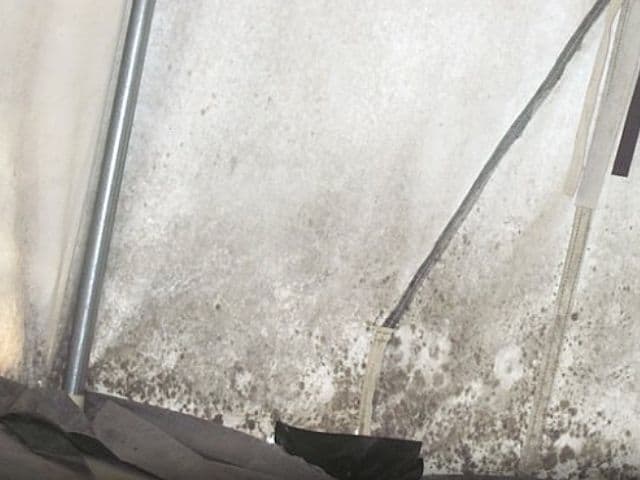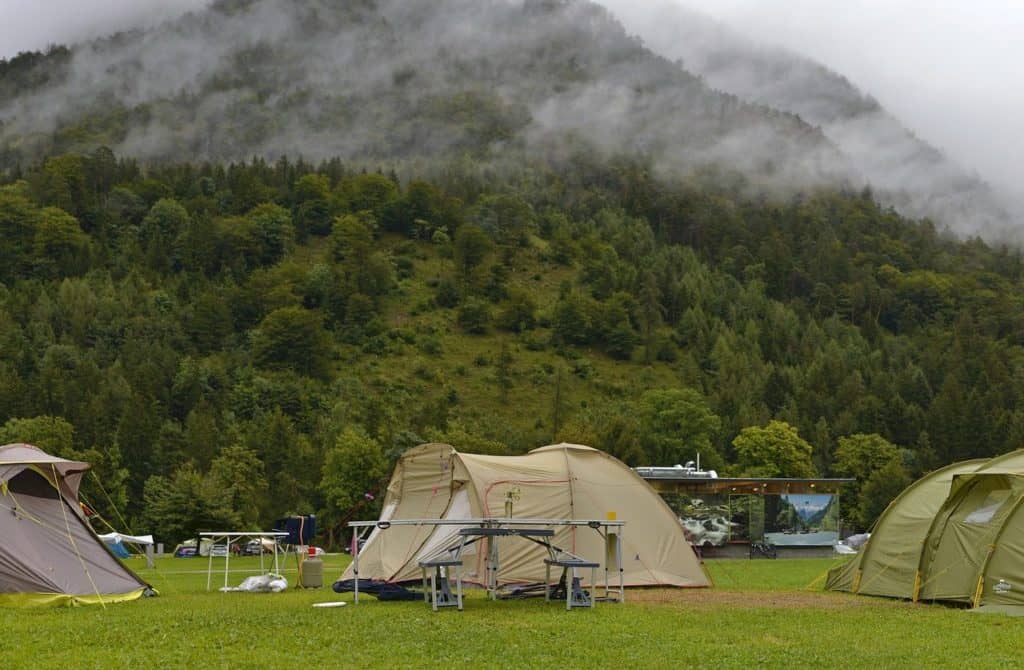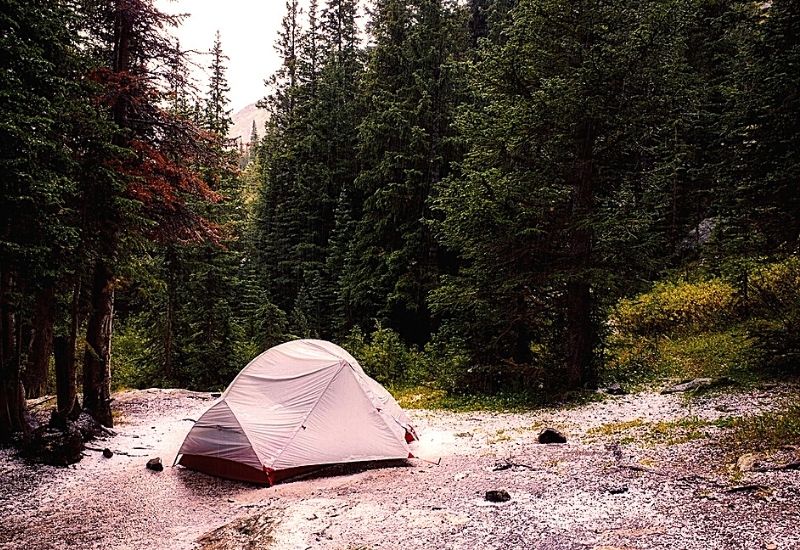While we all wish for perfect weather whenever we go caping.
The reality is, is that mother nature doesn’t always cooperate. As we will usually have to deal with a few rainy days while camping, which can lead to a damp or even a wet camping tent.
Presenting a real issue when it’s time to take down and put away the tent.
So can you put a tent away wet?
You ideally should never put a tent away wet, as this can lead to mold and mildew issues.
However, if you’re at the end of a camping trip and don’t have time to wait for the tent to dry, you can take a wet tent down and put it away. As long as it’s only for a short period of time and it’s thoroughly dried out as soon as possible and before long-term storage.
But there is a lot more to know about taking down and storing a wet tent than just this.
So if you’re planning to store a tent wet or think you might have to store a tent wet, make sure to keep reading.
How to Take Down a Wet Tent After It Rains?
While you always want to take down and pack away a tent when it’s completely dry, this is not always possible when your camping and backpacking.
Especially while camping during the spring and fall, as there tends to be a lot more rain and precipitation during these times of the year.
The good news, however, is that there are a few simple things you can do when taking down and putting away a tent after a rainy couple of days of camping, that will make things a lot easier.
Keep Wet and Dry Items Separate
While there is nothing you can do about your tent being wet when it’s time to pack up camp after a rainy camping trip.
There is no reason you need to make things worse and get the rest of your camping gear wet, just because your tent happens to be wet.
So when taking down and storing a damp or wet tent you want to keep it separate from the rest of your dry camping and backpacking gear.
By using either a dry bag or dry sack like this popular one on Amazon or just a simple trash bag, if your camping on a budget or don’t happen to have a dry bag handy.
That way you’re not compounding the problem by letting your wet tent get the rest of your camping gear wet.
Don’t Try to Stuff Your Wet Tent Back Into Its Storage Bag
While you might be tempted to try and stuff your wet tent back into its storage bag.
It’s best to fully dry the tent before doing so, in order to reduce frustration while tearing down camp and to help save time.
Because let’s face the tent and all its components including the rainfly, tent poles, guylines, and tent stakes barely fit into its compression storage sack even in the most ideal of circumstances.
So the last thing you want to be doing is trying to shove everything back into the tent’s compression storage bag while everything is wet.
Also by not storing the tent in its designated compression storage bag, it will remind you that the tent needs to be fully dried out at the earliest opportunity before it’s stored long term.
Make Sure to Completely Dry The Tent As Soon As Possible
The most important thing to remember when taking down and storing a wet tent is that you want to dry out the tent as soon as possible.
In order to prevent mold and mildew from forming on the tent fabrics and materials.
Because it can be very difficult to completely get rid of mold and mildew on a tent, once it’s allowed to form.
Which can lead to a very musty-smelling tent even after it drys out.
How Long Does it Take Different Tent Fabrics to Dry?
How long a tent takes to dry depends on many factors including the ambient temperature outside, the level of humidity in the air, whether the sun is out or not, the material the tent is made from, and how saturated the tent material is.
But the below table should give you a general idea of long it will take to naturally dry out your tent based on the type of fabric the tent is constructed with.
| Tent Fabric | Drying Time |
| Nylon | 4 to 6 Hours |
| Polyester | 2 to 4 Hours |
| Canvas | 6 to 12 Hours |
| Poly-Cotton | 4 to 8 Hours |
How to Dry a Wet Tent Fast and Speed Up the Drying Process
While the table above gives you a good idea of how long it will take to naturally dry out a tent based on the type of material it’s made from.
If you’re looking for ways to dry out a tent fast or speed up the drying process, we’ve got you covered.
As we’ve listed all the best tips and tricks to quickly dry out a tent below.
- The more wind and airflow you can expose the tent to the faster the tent will dry. So if you’re camped in an area with little wind or air flow move your tent in an open clearing with plenty of wind.
- Another natural way to speed up the drying process on a tent is to expose the tent to sunlight. So if you’re camped in a shaded area with very little sun, move your tent to an open area with lots of sunlight to dry the tent faster.
- Use a shammy or absorbent towel to wipe down both the inside and outside of the tent to remove excess moisture.
- Give the tent a little shake to remove standing water or moisture from the tent that might be sitting on the rainfly or the body of the tent.
What Happens if You Put a Tent Away Wet?

While you might think a wet or damp tent would need to be stored for an extended period of time before it became an issue.
In reality, mold and mildew can start to form on the fabric of a tent in as little as 24 to 48 hours, which can lead to a musty tent odor and even potential health issues.
And while you can clean mold and mildew from tent fabric (which we will discuss in the next section) it can be very difficult to completely remove once it’s formed.
So it’s definitely something you want to avoid.
In addition, if water is allowed to penetrate and sit on tent fabrics for extended periods of time while stored long term, it can actually cause the delicate tent fabrics to break down and rot over time.
How to Clean a Tent and Remove Mold and Mildew
Even if you always make sure to store your tent completely dry, over time, it’s still possible for a tent to have a slight musty odor on the inside or develop a few spots of mildew here and there, just as a byproduct of camping outdoors.
This means you’ll need to clean your tent from time to time to properly care for and maintain the tent.
However due to the delicate and lightweight tent fabrics often used in today’s modern tents, it’s important to not use any harsh chemicals or cleaning techniques, so you don’t damage the tent’s fabrics.
So below we have listed everything you will need and complete step-by-step instructions to properly clean a tent.
What You’ll Need to Clean a Tent and Remove Mold and Mildew
- Mild Dish Soap
- Cloth or Sponge
- Rubbing Alcohol (To Remove Tree Sap if Needed)
- Tech Wash from Nikwax (Buy on Amazon by Clicking Here)
- Revivex Odor Eliminator for Strong Odors (Buy on Amazon by Clicking Here)
- Bath Tub or Other Large Tub
Step-By-Step Instructions to Clean a Tent and Remove Mold and Mildew
- Spot clean any areas that are heavily soiled with a sponge and mild dish soap.
- If sap droppings are on the tent you can dab the spots with rubbing alcohol to break down the tree sap.
- Fill a tub with cold or lukewarm water and add the Nikwax Tech Wash as directed.
- Unzip the doors and turn the tent inside out.
- Submerge and soak the tent and the tent fly in water for the time specified time on the Nikwax Tech Wash bottle.
- Thoroughly rinse the tent with lukewarm or cold water.
- Soak the tent in Revivex Odor Eliminator as directed. (Only for Tents With Strong Odors and Not Required)
- Allow the tent to air dry while keeping it out of direct sunlight, making sure to move it around occasionally to ensure that every surface dries completely.
How Long Can You Leave a Tent Wet?
If you’re forced to take down and put a tent away wet, you want to limit the time the tent is stored wet as much as possible.
And you never want to store a tent wet for longer than 12 hours, in order to prevent mold and mildew from forming on the tent surfaces.
Can You Dry a Tent with a Towel?
While a towel or shammy will not completely dry a tent, it can help to significantly speed up the drying process by removing excess water and moisture from the tent’s surfaces.
But for maximum benefit, you want to use a super absorbent towel or shammy like this super popular one on Amazon from CleanTools and you also want to make sure you fully wipe down every surface of the tent including not only the outside surfaces but also the inside surfaces to remove any condensation that might have built up on the inside of the tent.
Can I Put a Tent in the Dryer?
You should never put a tent in the dryer, as the high heat of a dryer and tumbling action can easily damage delicate tent fabrics and significantly shorten the life of the tent.
Instead, it’s always best to let your tent air dry naturally if the tent becomes wet or damp.

Different Ways to Keep a Tent Dry
One of the best ways to keep a tent dry is to never allow the tent to become wet or damp in the first place by using the below tips and techniques.
- Invest in a Quality 3 Season Tent – One of the best ways to keep a tent dry is to buy a quality waterproof 3 season tent that will shed and wick away water instead of allowing the water to penetrate the tent’s fabric.
If you’re looking for a good quality waterproof tent that can handle the rain, check out our article “What is the Best Coleman Tent for Rain“.
- Use a Free Standing Rainfly – Another great way to keep your tent dry is to use a free-standing rainfly that’s independent of the main tent. As a free-standing rainfly can act as an outer tent protecting your main tent or inner tent from water and rain.
- Routinely Refresh the Tents Waterproofing – All waterproof tents use a waterproof coating to give the tent its waterproof capability, which over time will fade. So to maintain your tent’s waterproofing, you will need to refresh it from time to time, by using a product like Nikwax Waterproofing Spray or KIWI Camp Dry Water Repellent on the main body of the tent and Gear Aid Seam Sealant on the seams of the tent every 12 months or as needed.
- Use a Groundsheet – A good groundsheet or ground cover can go a long way in helping to keep your tent dry, as it will keep water and moisture away from the bottom and floor of your tent.
To see all the best groundsheets or ground covers for a tent, check out our article “Best Tent Footprint: Choosing the Best Tent Footprint“.
How Do You Keep a Tent from Molding?
There are several things you can do to keep a tent from molding, which we have listed below.
- Always store your tent completely dry and never store your tent long-term wet or even damp.
- Store your tent in a cool dry place away from humidity and excess moisture.
- Use a mold blocker or antimicrobial spray on the tent fabric, like this popular one on Amazon from Mold Armor.
- Keep your tent clean and remove any debris or dirt, which can be breeding grounds for mold and mildew.
- Ventilate and air out the tent as much as possible while camping, by opening the windows and built-in vents to allow air to pass through the tent.

